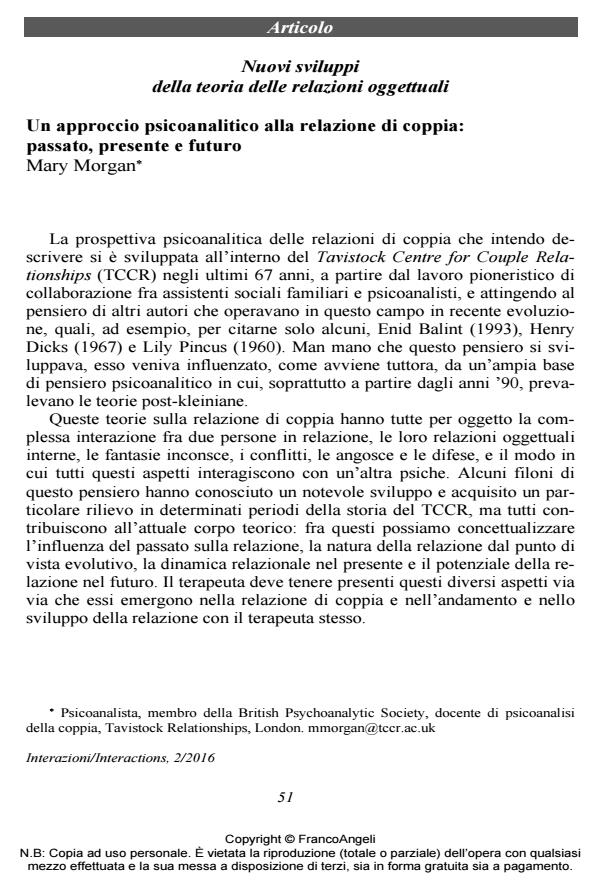Un approccio psicoanalitico alla relazione di coppia: passato, presente e futuro
Titolo Rivista INTERAZIONI
Autori/Curatori Mary Morgan
Anno di pubblicazione 2016 Fascicolo 2016/2 Lingua Italiano
Numero pagine 13 P. 51-63 Dimensione file 172 KB
DOI 10.3280/INT2016-002006
Il DOI è il codice a barre della proprietà intellettuale: per saperne di più
clicca qui
Qui sotto puoi vedere in anteprima la prima pagina di questo articolo.
Se questo articolo ti interessa, lo puoi acquistare (e scaricare in formato pdf) seguendo le facili indicazioni per acquistare il download credit. Acquista Download Credits per scaricare questo Articolo in formato PDF

FrancoAngeli è membro della Publishers International Linking Association, Inc (PILA)associazione indipendente e non profit per facilitare (attraverso i servizi tecnologici implementati da CrossRef.org) l’accesso degli studiosi ai contenuti digitali nelle pubblicazioni professionali e scientifiche
In questo articolo viene proposto un approccio psicoanalitico alla comprensione della relazione di coppia basato su elementi del passato, del presente e del futuro. Sulla relazione di coppia attuale influiscono aspetti di ciascuno dei partner e ad essi la coppia può rispondere in maniera difensiva o evolutiva. Il presente viene valutato in termini evolutivi e dinamici, nel senso di considerare sia come la coppia si collochi nello sviluppo psichico del processo di "essere una coppia", sia in che modo essa gestisca la dinamica dell’esistenza di "un altro" nella relazione. Il futuro è considerato dal punto di vista di come la coppia potrebbe proseguire il suo sviluppo nell’ambito di una relazione che possa esser creativa per entrambi, sia insieme, sia individualmente. Segue un breve esempio clinico.;
Keywords:Coppia, scelta inconscia del partner, patto inconscio, relazione transferale di coppia, fantasma inconscio condiviso, proiettivo gridlock, alterità, legame, interferenze, coppia creativa.
- Bannister K., Pincus L. (1965). Shared Phantasy in Marital Problems: Therapy in a four-person Relationship. London: Institute of Marital Studies.
- Balfour, A. (2015) Transference and enactment in the ‘Oedipal setting’ of couple psychotherapy In: A. Novakovic, Couple Dynamics: Psychoanalytic Perspectives in Work with the Individual, the Couple, and the Group. London: Karnac.
- Balint E. (1993). Unconscious communication between husbands and wives. In: S. Ruszczynski (Ed.), Psychotherapy with Couples: Theory and Practice at the Tavistock Institute. London: Karnac.
- Berenstein I. (2012). Vínculo as a Relationship between others. Psychoanalytic Quarterly, 81: 565-577.
- Britton R. (1998). Belief and imagination. Explorations in psychoanalysis. London: Routledge.
- Britton R. (2000). On Sharing Psychic Space. Society of Psychoanalytical Marital Psychotherapists Bulletin 7, May Issue.
- Cleavely E. (1993). Relationships: interaction, defences, and transformation. In: S. Ruszczynski (Ed.), Psychotherapy with Couples: Theory and Practice at the Tavistock Institute. London: Karnac.
- Colman W. (1993). Marriage as a psychological container. In: S. Ruszczynski (Ed.), Psychotherapy with Couples: Theory and Practice at the Tavistock Institute. London: Karnac.
- Colman W. (2005). The intolerable other: the difficulty of becoming a couple. Couple and Family Psychoanalysis 4(1): 22-41.
- Dicks H.V. (1967). Marital tensions. Clinical studies towards a psychological theory of interaction. London: Karnac. [Trad. it. Tensioni coniugali. Roma: Borla].
- Fisher J. (1999). The Uninvited Guest. Emerging from Narcissism towards Marriage. London: Karnac.
- Freud S. (1920). Al di là del principio di piacere. OSF, vol. 9. Torino: Bollati Boringhieri
- Klein M. (1946). Notes on some schizoid mechanisms. In: M. Klein, Love, Guilt and Reparation. London, Hogarth Press.
- Morgan M. (1995). The projective gridlock: a form of projective identification in couple relationships. In: S. Ruszczynski, J. Fisher (Eds.), Intrusiveness and Intimacy in the Couple. London: Karnac.
- Morgan M. (2001). First contacts: the therapist’s ‘couple state of mind’ as a factor in the containment of couples seen for initial consultations. In: F. Grier (Ed.), Brief Encounters with Couples. London: Karnac.
- Morgan M. (2005). On being able to be a couple: the importance of a ‘creative couple’ in psychic life. In: F. Grier (Ed.), Oedipus and the Couple. London: Karnac.
- Morgan M. (2010). Unconscious beliefs about being a couple. Fort Da, 16: 36-55.
- Morgan M., Ruszczynski S. (1998). Psychotherapy with couples: towards the creative couple. Unpublished paper. Tavistock Institute of Marital studies 50th Anniversay Conference.
- Ogden T. (1979). On projective identification. International Journal of Psycho-Analysis, 60: 357-373.
- Ogden T. (1994). Subjects of Analysis. Northvale, NJ: Jason Aronson. [Trad. it. Soggetti dell’analisi. Amsterdam: Elsevier editore].
- Pickering J. (2006). The marriage of alterity and intimacy: a couples perspective. In: S. Brookes, P. Fullerton (Eds.), Psychoanalytic Perspectives on Couple Work: An International Publication. London: Society of Couple Psychoanalytic Psychotherapists, 2006.
- Pincus L. et al. (1960). Relationships and the Growth of Personality Marriage: studies in emotional conflict and growth. London: Institute of Marital Studies.
- Pincus L. (1962). The nature of marital interaction. In: The marital relationship as a focus for casework. Tavistock Institute of Human Relations. Institute of Marital Studies.
- Ruszczynski S. (Ed.) (1993). Psychotherapy with couples. Psychotherapy with Couples: Theory and Practice at the Tavistock Institute London: Karnac.
- Ruszczynski S., Fisher J. (Eds.) (1995). Intrusiveness and Intimacy in the Couple. London: Karnac.
- Ruszczynski S. (1998). The ‘Marital Triangle’: Towards ‘Triangular Space’ in the Intimate Couple Relationship. Journal of the British Association of Psychotherapists, 34(31), 33-47.
- Scharff, D.E., Scharff J.S. (2011). The interpersonal unconscious. Jason Aronson: UK.
- La transizione separativa Marina Mombelli, in INTERAZIONI 2/2020 pp.48
DOI: 10.3280/INT2020-002004
Mary Morgan, Un approccio psicoanalitico alla relazione di coppia: passato, presente e futuro in "INTERAZIONI" 2/2016, pp 51-63, DOI: 10.3280/INT2016-002006